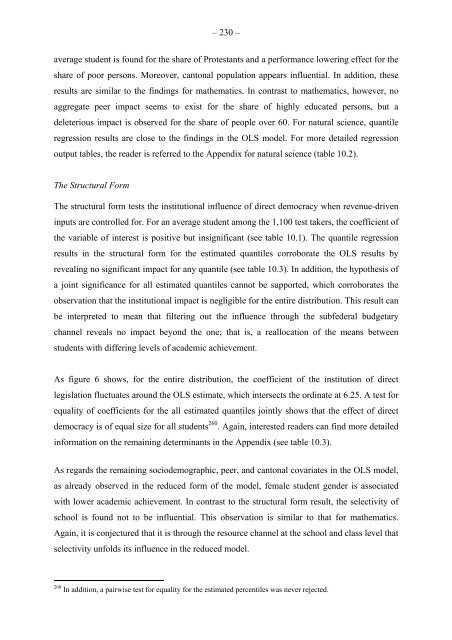The Impact of Direct Democracy on Society - Universität St.Gallen
The Impact of Direct Democracy on Society - Universität St.Gallen
The Impact of Direct Democracy on Society - Universität St.Gallen
- No tags were found...
Create successful ePaper yourself
Turn your PDF publications into a flip-book with our unique Google optimized e-Paper software.
– 230 –average student is found for the share <str<strong>on</strong>g>of</str<strong>on</strong>g> Protestants and a performance lowering effect for theshare <str<strong>on</strong>g>of</str<strong>on</strong>g> poor pers<strong>on</strong>s. Moreover, cant<strong>on</strong>al populati<strong>on</strong> appears influential. In additi<strong>on</strong>, theseresults are similar to the findings for mathematics. In c<strong>on</strong>trast to mathematics, however, noaggregate peer impact seems to exist for the share <str<strong>on</strong>g>of</str<strong>on</strong>g> highly educated pers<strong>on</strong>s, but adeleterious impact is observed for the share <str<strong>on</strong>g>of</str<strong>on</strong>g> people over 60. For natural science, quantileregressi<strong>on</strong> results are close to the findings in the OLS model. For more detailed regressi<strong>on</strong>output tables, the reader is referred to the Appendix for natural science (table 10.2).<str<strong>on</strong>g>The</str<strong>on</strong>g> <strong>St</strong>ructural Form<str<strong>on</strong>g>The</str<strong>on</strong>g> structural form tests the instituti<strong>on</strong>al influence <str<strong>on</strong>g>of</str<strong>on</strong>g> direct democracy when revenue-driveninputs are c<strong>on</strong>trolled for. For an average student am<strong>on</strong>g the 1,100 test takers, the coefficient <str<strong>on</strong>g>of</str<strong>on</strong>g>the variable <str<strong>on</strong>g>of</str<strong>on</strong>g> interest is positive but insignificant (see table 10.1). <str<strong>on</strong>g>The</str<strong>on</strong>g> quantile regressi<strong>on</strong>results in the structural form for the estimated quantiles corroborate the OLS results byrevealing no significant impact for any quantile (see table 10.3). In additi<strong>on</strong>, the hypothesis <str<strong>on</strong>g>of</str<strong>on</strong>g>a joint significance for all estimated quantiles cannot be supported, which corroborates theobservati<strong>on</strong> that the instituti<strong>on</strong>al impact is negligible for the entire distributi<strong>on</strong>. This result canbe interpreted to mean that filtering out the influence through the subfederal budgetarychannel reveals no impact bey<strong>on</strong>d the <strong>on</strong>e; that is, a reallocati<strong>on</strong> <str<strong>on</strong>g>of</str<strong>on</strong>g> the means betweenstudents with differing levels <str<strong>on</strong>g>of</str<strong>on</strong>g> academic achievement.As figure 6 shows, for the entire distributi<strong>on</strong>, the coefficient <str<strong>on</strong>g>of</str<strong>on</strong>g> the instituti<strong>on</strong> <str<strong>on</strong>g>of</str<strong>on</strong>g> directlegislati<strong>on</strong> fluctuates around the OLS estimate, which intersects the ordinate at 6.25. A test forequality <str<strong>on</strong>g>of</str<strong>on</strong>g> coefficients for the all estimated quantiles jointly shows that the effect <str<strong>on</strong>g>of</str<strong>on</strong>g> directdemocracy is <str<strong>on</strong>g>of</str<strong>on</strong>g> equal size for all students 260 . Again, interested readers can find more detailedinformati<strong>on</strong> <strong>on</strong> the remaining determinants in the Appendix (see table 10.3).As regards the remaining sociodemographic, peer, and cant<strong>on</strong>al covariates in the OLS model,as already observed in the reduced form <str<strong>on</strong>g>of</str<strong>on</strong>g> the model, female student gender is associatedwith lower academic achievement. In c<strong>on</strong>trast to the structural form result, the selectivity <str<strong>on</strong>g>of</str<strong>on</strong>g>school is found not to be influential. This observati<strong>on</strong> is similar to that for mathematics.Again, it is c<strong>on</strong>jectured that it is through the resource channel at the school and class level thatselectivity unfolds its influence in the reduced model.260 In additi<strong>on</strong>, a pairwise test for equality for the estimated percentiles was never rejected.
















